How are you handling the pressure of life being back ON? If you’re feeling a bit anxious, overwhelmed, or stuck, this article will help you. I have 7 tips for
Clothes Closets, especially walk-in closets, are a problem area in many homes. If this is you, help is on the way!
Even though I am a professional organizer, I admit, purging my own clothes can be hard!
The problem with closets is they are out of sight, out of mind. No one else sees the master bedroom closet but you, your family, and maybe your cleaning person.
It’s all too easy to let clothes and accessories accumulate over time in your walk-in closet. And before you know it, you are having to shove the hangers in because your clothes are packed as tight as sardines!
One common result of this is that you cannot see or remember what you have.
So, you end up buying duplicate items because you cannot find what you’re looking for.
Which means you’re spending hard-earned money to buy duplicate items! This is especially true for people who have more than one closet where they store clothes and accessories–they forget what they have in the other clothes closet.
And yes, I have had several organizing clients who have 2 or even 3 closets or a room full of clothes!
Before you even get started, it’s a good idea to remind yourself of the WHY, why are you doing this?
(That way, you’ll be in the right mindset to let go.) Next, let’s look at this important question:
What is your WHY?
You are not alone! Thousands of women and men in the US want these things too. Did you know that clutter has a “negative impact on our subjective well-being”? It’s true.
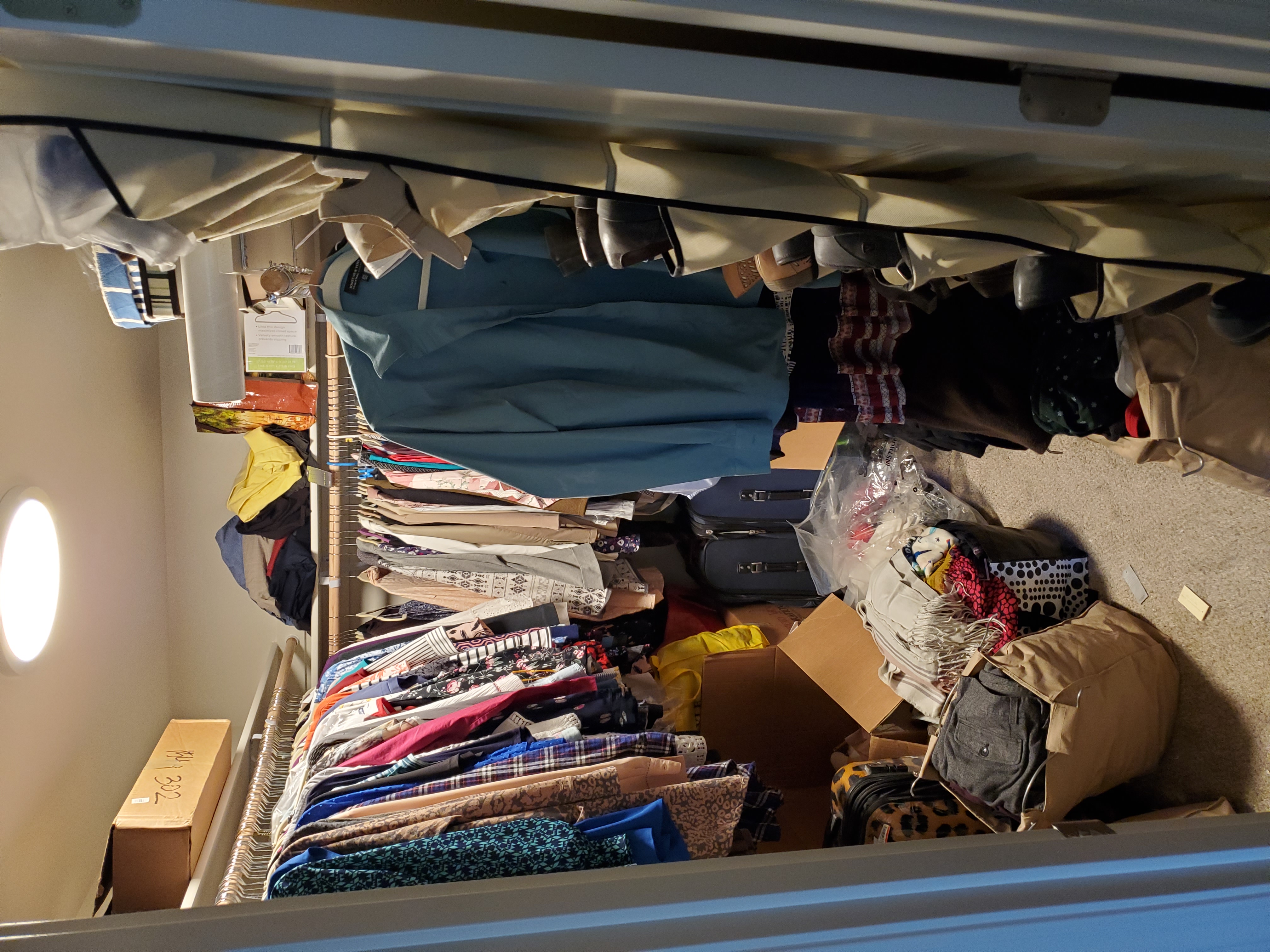
Did you know, messy homes leave us feeling anxious and overwhelmed?
Also, messy homes and workspaces leave us feeling anxious, helpless, and overwhelmed, according to a recent Huffington Post article.
If you’d like to feel better, purging and organizing your packed walk-in closet is the way to go!
It’s time to dig deep and find the strength to let go. Purging your own clothes is hard! So, get yourself into a tough mindset by using the questions in the last section.
In addition, a loving heart can motivate you to purge your clothes. Here’s how.
I promise you’ll have an easier time giving away clothes by visualizing the look of joyful surprise on the face of the person who finds just what they needed at a thrift store (thanks to your generous clothing donation.)
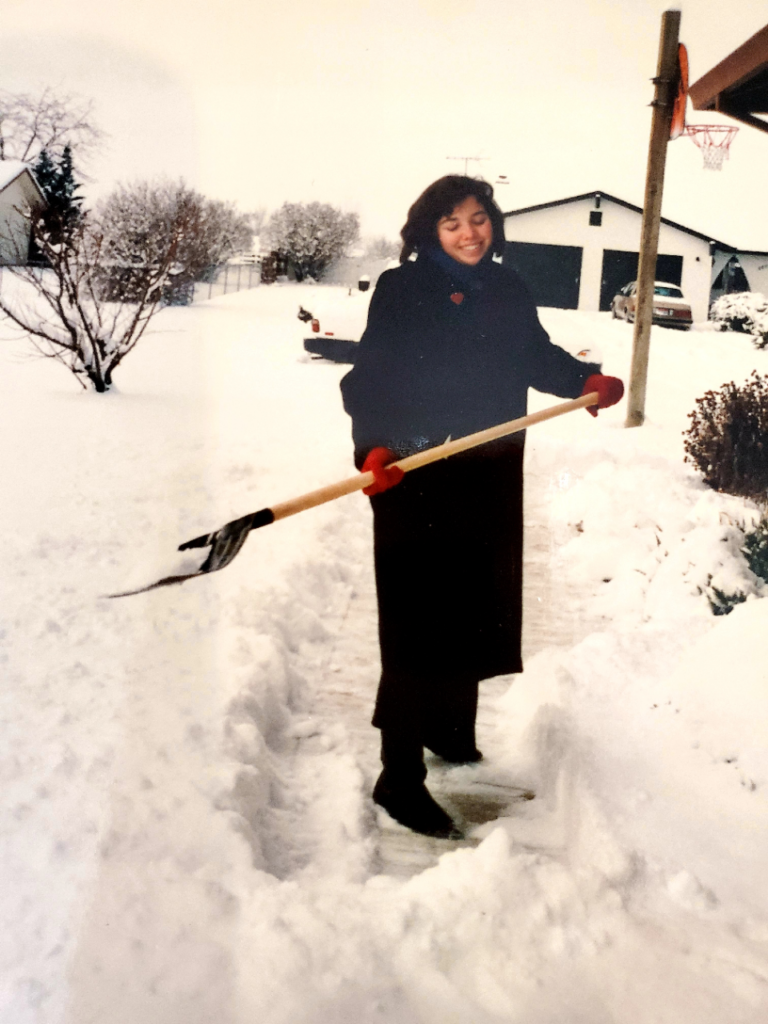
This is me on my mission, shoveling snow & wearing my warm thrift store find!
Circa 1990.
I remember when I was a poor college student in Provo, Utah. I needed a warm dress coat for my upcoming mission. I browsed at TJ Maxx and the coats didn’t look very warm, so I decided to search some thrift stores to find a warm coat. (I had plenty of time, just not much money back then, so I didn’t mind combing the city for a coat!)
I ended up finding a super-warm dress coat that buttoned all the way up and covered my neck—I was so happy! (Most women’s dress coats have a V-neck.) It was constructed of thick black wool, lined with thick black satin, and lasted many years!
So, it will help to picture all the poor or low-income working people who can use some of the clothes you never wear—especially if that motivates you to let go.
The purging phase is the most important part of the closet edit.
I’ve come up with some questions for you to make the process easier. My hope is these questions will help you make good decisions you’ll be happy with.
One caution: Do this when you are in a tough, not a lenient state of mind. If you under-purge, you’ll regret it because you’ll have to do this again in 6 months or live with a packed closet.
That’s a simple yes or no. If it doesn’t fit right now, let it go. In some cases, I do allow a client to keep 1 small box of clothes which are too small. I call it the “skinny pants” box. 🙂
Definitely have a full-length mirror and some good lighting while you try clothing on! There will be some no-brainers here, but some clothes you are going to need to try on. Don’t be daunted. Do it!
Last time I did this with a client, she tried on a whole walk-in closet full of clothes in just two hours, with my help.

“A woman is never sexier than when she is comfortable in her clothes.” ~Vera Wang
You may have had some great times wearing that sequined dress, but if all your kids have married and you don’t go to swanky New Year’s parties, are you really going to wear it again?
If the answer is an emphatic YES, then keep it. If you’re waffling, or rationalizing why you should keep it, let it go, that’s a nope!
Be sure not to let the cost of the item keep you from letting it go. It won’t do you any good to let that fur coat sit in your walk-in closet taking up prime real estate for the next 10 years.
Sell it if that makes you feel better, but DO take it out of your closet and say goodbye!
The best thing to do, which takes the least amount of time, is to just let go.
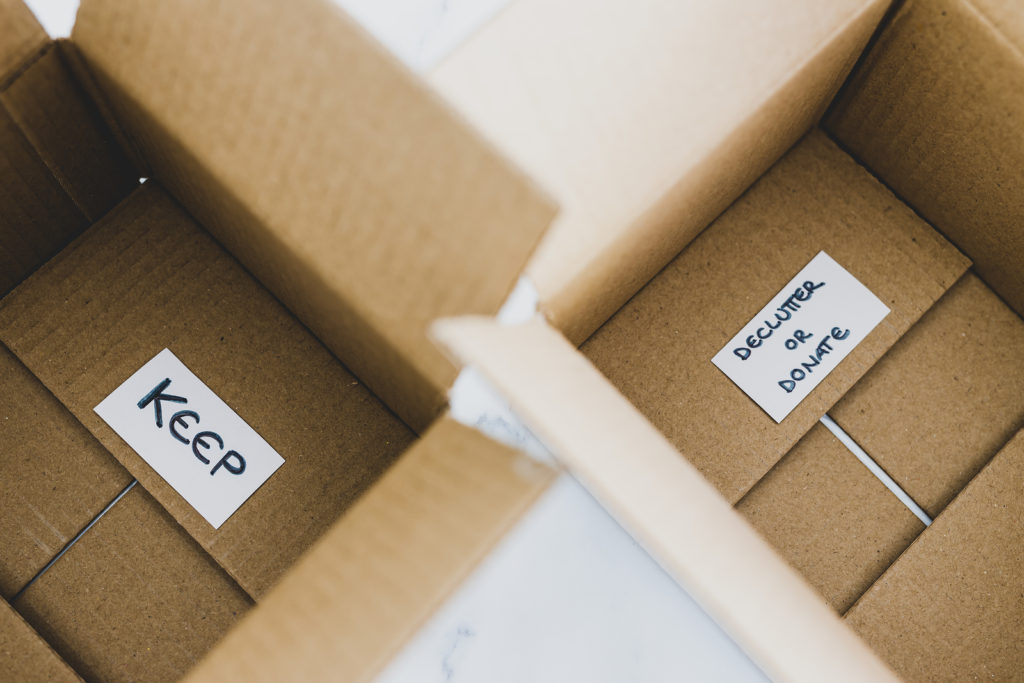
I recommend just giving things away so you can move on.
Here’s a caution, though, take care not to make the donation process too difficult, or you won’t do it. For example, some people have 5 bags of stuff going to different friends. That is too complicated, too much work! Much better to take it to one thrift store so those bags don’t clutter up your house for months.
Make it easy on yourself and you’re much more likely to do it.
Be careful not to make up big, unrealistic scenarios for when you might use an item in the future. Example: “I’ll wear this one-piece hot-pink and yellow snowsuit from the 80s if I ever ski again.” See how silly that sounds?
Be brutally honest with yourself in this process of purging and organizing your closet.
As I like to say: be ruthless, not reckless when you purge.
Purging is a MUST to have the pretty, organized closet you desire.
And just think; once you purge all the stuff you never wear, it’s going to be so much easier to find what you want and get ready every morning. Not to mention, much faster!
Best of all, you can dress for work (or play) with a feeling of confidence now that you know everything in your closet makes you look and feel good.
“Why Clutter Can be So Bad for People With Anxiety (And What To Do About It,” Huffington Post, 4/8/2021
The dark side of home: Assessing possession ‘clutter’ on subjective well-being. March 2016, Journal of Environmental Psychology, 46.
Has setting up your home office during COVID-19 virus been a headache? If productivity has been an issue for you, I’ll share some organizing and time management hacks that will make a huge impact on your work.
What people working at home don’t realize: everyone has an inner productivity circle.
In fact, if you think about your home office as a series of circles radiating away from you (like the parallel ripples that radiate out when you drop a rock into a still pool of water), you’ll realize that what you keep close to you is important.

I first learned about this concept from my organizing mentor, Porter Knight. She talks about it in her book, Organized to Last. In it, she coined the term ‘concentric circles’.
I recently taught this productivity principle at a lunch and learn for a large local company. Several people were blown away by this principle; the idea that your work output increases when you only keep frequently used items within arms’ reach.
It makes total sense to me, if you spend less time getting up to use tools in the office, your workday will be more efficient. I will illustrate.
Circle 1: For me, the tools I use every day several times a day need to be in my inmost work circle of my home office. I should not have to roll my chair or even swivel it to get the items I use more than twice a day.
Items in my inner productivity circle: computer, mouse, planner or to-do list, pens, Post-its, stapler, tape, tool drawer, timer, hand lotion, drawer of important files, and trash can.
You may need additional tools like a 10-key, calculator, or specialized items for the work you do.
Circle 2: The next layer for efficient work at home would contain tools and resources you might use once a day. For example: file drawers, your tissue box, projects file, business card binder, cork board or whiteboard, speakers, etc.

Circle 3: The Third layer, the one farthest from you, would have things like resource books, archived files, office supply storage, camera equipment, supplies you travel to clients with, a briefcase or bag for networking events, etc. This layer holds supplies or archives used occasionally or rarely.
When I work with a client, we concentrate on creating open space around them in their home office, The problem with most work spaces is they have TOO MUCH STUFF cluttering their inner circle. this is true for many who are working at home.
Stuff that clutters up our desks: papers that need to be filed, projects, ideas, mail, Post-its, business cards, books, food, and personal items unrelated to your work or comfort are some of the clutter.
Did you know that clutter actually distracts from your work? Visual clutter, like stacks of paper, magazines, or too much in your inbox contribute to a state of low-level anxiety for some people.
Watch what happens when you clear off all the clutter from your desk and floor in your home office. I know every time I put all my papers away in files or project binders, I feel a rush of energy and am motivated to tackle the most important task of the day. Try it, you’ll like it!
Some people I’ve worked with are comfortable with one pile of work on their desk or a large inbox, and that’s fine. The important thing is to find what works best for you.
To help you even more, I’ll share a list of tips for staying productive while working at home. Time management tips like these are sorely needed in these unprecedented times when all the kids are home attending virtual classes because of COVID.
Figure out what your best focus time is. Do the work that requires the most brainpower then. If you’d like to pinpoint the time of day, email me and I will send you a quiz that will show you when you do your best work! jennym@efficientspacesco.com
If your spouse or kids are home during work hours, make sure they know not to disturb you. Close the doors if you need to. Put on headphones with some music that helps you focus. This has a dual job: to let people know you don’t want to be disturbed, and it keeps you from hearing background noise.
“Ambient sounds, especially with words, occupy about 5-10% of your intellectual bandwidth. By wearing ear protectors, you acoustically isolate yourself. This freed up bandwidth can now be focused on the desired task.
It’s a great deal. Just put on some earmuffs and you become 5-10% smarter.”
~ Peter Rogers, Straight A Stanford and on to Harvard
To be effective, make a plan for your week and then break it down by the day. I I start out with a ‘dump list’ then transfer the tasks to my planner, which uses a funnel-down system to help me choose which day to put each task. I use my planner for my to-do list, but a notebook or a sticky note works well to identify the most important daily tasks. For most people, having a daily purpose is a huge motivator. It’s satisfying to check those items off when they’re finished! I would be lost without my to do list. Most professionals who excel at time management use some form of a to-do list, whether electronic or paper. *I use the Planner Pad Organizer.
With emails, you can take one of 3 actions: File, respond, or delete. Try not to think about it too much! It doesn’t have to be complicated. The general rule of thumb: if it takes 2 minutes, do it now. (From Getting Things Done by David Allen)
Also, have folders for emails or email categories. Organize them by topic, project, or individual names. A person wastes 6 weeks annually searching for lost documents or because of unorganized folders for the one project they need. Be consistent about filing them. It helps so much when you need that information later!
Have an inbox for paper, and clear it daily.
Have a “hot spot” for today’s most urgent project. Personally, I prefer a clear file folder standing up in a vertical file sorter. My home office file sorter holds 5 files. Also, put your to-do list in plain sight and review it each morning before you start.
Definitely prioritize projects based on their ROI and on the deadline or due date!
If you tend to distract yourself: ahem… yes I do that! I find that setting a timer is very helpful. This works well if you are easily distracted by “bright and shiny” new emails. Say your purpose for opening your email is to write one necessary email and then close the email so you can focus on a project. Set a timer for 15 minutes before you open your inbox to avoid getting “sucked in” by your email. This really works! (I keep my timer within arm’s reach in my home office.)
“One way to boost our will power and focus is to manage our distractions instead of letting them manage us.” ~ Daniel Goleman
If texts, incoming emails, Zoom pop-up, or calendar notifications have alerts that distract you when you are trying to focus in your home office, make sure to turn off those alerts for the hour or 90 minutes when your project needs your full attention. (Before you do this, check your calendar to make sure you don’t have a meeting or scheduled phone call.) If you are not sure how to do this, ask a tech-savvy friends! Or link to the article I provide at the end of this post.
Delegate email deletion and unsubscribing from sites to your kids or grandkids (it works great!). Also, make sure to limit spam by having good firewalls in place to limit what gets to your inbox.
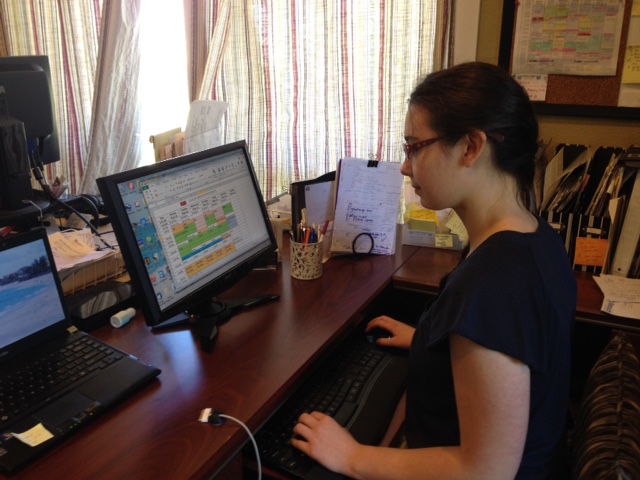
For information you want or need to keep, have it scanned by someone you can delegate to (an assistant, tech-savvy son/daughter, grandchild, high school student) and file or organize it into files. Make sure and have the helpers to do it at a time when you’re doing something low-focus, like responding to emails. That way the interruptions with questions won’t affect your productivity in your home office.
Use these 10 tips to achieve more and reach your business goals!
Related posts: 5 ways to keep distractions at bay: https://efficientspacesco.c.wpstage.net/2015/02/5-tips-distractions-bay/
New Habits: you can do anything for 30 minutes: https://efficientspacesco.c.wpstage.net/2014/05/30-minutes/
How to get an extra hour of productivity daily: https://efficientspacesco.c.wpstage.net/2014/02/extra-hour/
How to turn off distracting notifications: http://www.makeuseof.com/tag/5-distracting-desktop-notifications-turn-windows/
5 Food Storage Basics
The point of food storage is to have food storage in place BEFORE an emergency strikes.
I just made a trip to a warehouse (owned by my church) to purchase a bunch of staples like flour, sugar, wheat, salt, etc. Back in February, I had the thought: I need to beef up our food storage! Organizing your food storage is so important for peace of mind when disaster strikes.

The reason: partly inspiration, partly because we had used a lot of flour and sugar last December. My son Jacob and I had baked and sold cookies to raise money for a school trip. So, I thought we were running low. (Turns out, we still had enough flour for 6 months in our storage.)
That brings me to the first step in organizing your food storage.
Have you ever gone to the grocery store and bought ketchup because you thought you were almost out, only to find you have 3 bottles of ketchup in your pantry?

It’s crucial to know what you already have stored. Not taking an inventory before you go to the store or get online leads to waste, because your family won’t be able to consume it before it spoils.
On the other hand, when you DO take an inventory of how much flour, sugar, yeast, oil, milk powder, salt, etc. you have stored, you won’t end up with waaay too much of one item. Or too little of another staple food. You might be surprised how fast you’ve used up the flour, for example.
Here’s what I do when I purchase food to put in storage: I put the date of purchase on the container. It’s helpful to keep records and to inventory your storage at least once a year.
If you want to know how fast your family uses up 10 pounds of flour, for example, there is an easy way to figure that out. Simply label the container with an “open date,” which is the date you started consuming the flour. A piece of masking tape or white duct tape works well.
Then, when you use the last of it, note the date on the tape. It’s a great trick. Just make sure to plan for extra usage during holidays like Christmas, when you’ll do a lot more baking.
What do you still need to “round out” your food storage? Do you have everything you need to make bread, for example? What about soup? How many different meals could you make with the food you already have on hand? If you only have the ingredients for 3 different meals during an emergency, you will get mighty tired of eating those 3 meals!
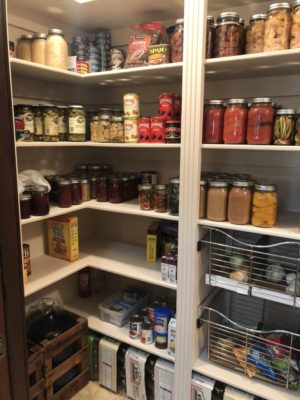
One thing we like to do for variety: purchase hiking meals and MREs. It provides us great choices without having to purchase a bunch of perishable ingredients for our food storage. And they last about 10 years! They are packaged in a pouch and quite light, especially the hiking meals. Everything you need to cook the meal is inside. Super efficient!
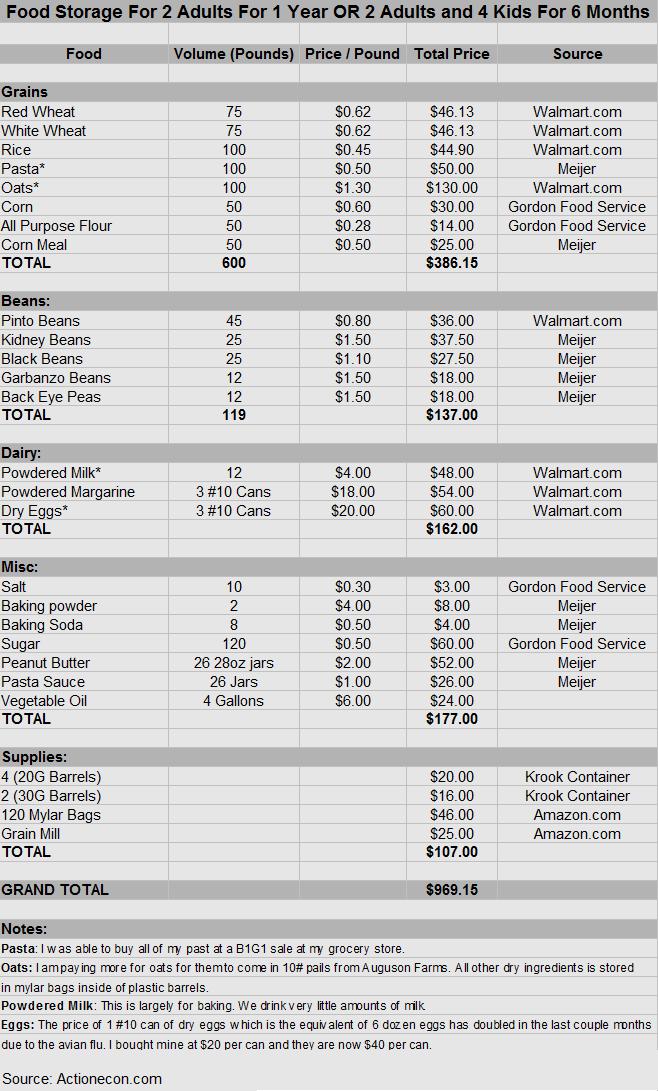
Being prepared will save you from fear, because you will rest easy knowing you have enough food, water and fuel to provide for your family.

I have not worried about food, or even toilet paper, since this pandemic struck the world. Why? Because I had prepared for a disaster. I was surprised it came this soon, but that didn’t matter. The essential matter is to be ready for anything.
If an emergency like the Covid-19 virus comes around again, plan for married children returning home to wait it out with you. Currently, we have 2 adult children home with us, plus one teenager. And we have plenty because we have enough food storage to feed 5 people that will last 6 months.
Definitely plan for the worst-case scenario. Purchase the food that will fill in your gaps. You can do this bit by bit, purchasing some supplies every month. Or you can buy it all at once.
You saw what happened during the COVID-19 scare when everyone tried to get their food storage at the same time. It’s chaotic and a bit scary. Stores started running out of many items like toilet paper, paper towels, bleach, flour, sugar, survival foods and foods with a long shelf-life.
Q: When is the time to get your food storage together?
A: Gather food storage BEFORE disaster strikes—not after!
President Gordon B. Hinckley, “If ye are Prepared ye Shall Not Fear,” Oct. 2005.
*Doctrine and Covenants 109:8 https://www.churchofjesuschrist.org/study/scriptures/dc-testament/dc/109.8?lang=eng#p8 D&C 109:8
**Doctrine and Covenants 38:30, https://www.churchofjesuschrist.org/study/scriptures/dc-testament/dc/38?lang=eng
Providentliving.org: https://providentliving.churchofjesuschrist.org/?lang=eng
Building a 6-month Food Storage Supply (with table listing foods and amounts) https://actionecon.com/building-a-6-month-food-storage-supply/
1 Year food Supply for a Family of 4 http://seasonedcitizenprepper.com/feed-a-family-of-4-for-1-year-for-less-than-300/
This is the BIG question everyone wants to know: how much does hiring an organizer cost, anyway? Do I have to be wealthy to get organized? Here’s some tips and tricks!

That very much depends on the size of the project, how fast the organizer is, how quickly you make decisions, and the amount of clutter and backlog in your home or office.
A new organizer may charge a lower hourly rate because she (and it’s almost always a she) doesn’t have much experience, so you’ll pay less per hour. For example, a 10-hour job may cost $500. A more experienced organizer will charge more and get the work done faster. She has thousands of hours of experience. Therefore, you might pay between $750 and $1000 for 10 hours of organizing. In large metropolitan areas, the organizing cost will be higher.
Also, most organizers give a discount for a package of hours, which is paid for after the initial meeting (the assessment). Most organizers give a 5 to 10 percent discount for paying up front, either at or before the first organizing session. This could save you hundreds of dollars in organizing cost over the life of the project. Link to similar article here.
Here’s a suggestion: do a cost/benefit analysis to see if a less experienced organizer is worth the savings. If your time is valuable, weigh the benefit of hiring a faster, more experienced organizer versus a slower, less experienced one. Since time is money, and money well spent saves time, the organizing cost is worth it.
When you ask a lawyer how much money it will cost to win your case, he doesn’t know because he cannot predict the research, how long the case will take, etc. Likewise, a professional organizer will not be able to tell you how long your project will take until she has finished the assessment and done at least 1 work session with you. This is not because she is inexperienced. A lot of variables come into play to determine the length of work: her speed, your decision-making speed, how much clutter you have to work through, and the level of organization you desire. Similar to presenting a court case, organizing is a process of preparing, making a plan, and working through all the clutter in your home and in your brain.
Organizing is a process, not a one-time event. As any professional organizer will tell you, she is often a coach as well as an organizer. She coaches you through the often-difficult process of letting go. Therefore, the number of hours she states as an estimate is just that—an estimate. Think about it this way: you wouldn’t say to your therapist—I’m only going to work with you for 10 hours, even if my PTSD isn’t fixed. S/he wouldn’t agree to see you as a patient.
Now apply that to organizing; if your project isn’t finished, the work with the organizer is not done either. The process of getting organized is logical. It is a multi-step project based on a proven method and an orderly completion of all the steps. So, if you skip a step, you sabotage the results. Complete the steps and you complete the project. And you have a lasting result. For tips on hiring an organizer, click here.
First, the pay-as-you-go option. In this model, you pay for each session at the time of service. This is easier to budget for because it will be a certain amount per week or per month. Also, the organizer cost will be full price; no discounts.

Second is the package option. In this model, you pay up front for a set number of hours. This requires a larger initial investment and commitment. The organizer will usually give you up to a 20 percent discount. As you can see, the package discount makes the professional organizer cost more doable.
An organizer prefers to sell a package because she knows a client is more likely to finish the project when they have paid for the whole package. It shows a level of commitment to finish. With the pay-as-you-go model, distractions or other monthly expenses may crowd out the organizing goal. Often, this is the case.
Keep in mind the reason organizers do what they do is because they like to help people. She is not in this profession because she wants to get rich. She is service minded and loves to see you successfully reach your goals for organization. You know the thrill you get when you serve someone who really needs it? Well, that how your personal organizer feels when she helps you improve your life. Especially if you tell her just how powerful an impact getting organized has had for you.
Most organizers, in the first meeting or intake, will ask what your budget is for the project. If you don’t know, she will share her rates with you and you decide the speed which you’d like to see results. Personally, I work with people’s budgets and have been known to give discounts to those who truly have limited resources.
When setting a budget, keep in mind the cost of not getting organized. What is the emotional and productivity cost of being disorganized? How much do you pay for storage units per month? How many bills have you missed due to lack of a system, which incurred late fees? Or, how many duplicate tools or other items have you purchased because you cannot find the one (or two) you already have somewhere? When you think about the cost in this light, the organizing cost is a bargain. Link to How Organizing saves you Money here.
Recently, a new client came to me, eager for my expertise. She told me she had read in an article that the cost of hiring a professional organizer is worth every penny. I agree. Link to article here
Need help? Contact me! I provide a free 30-minute exploratory call.
How Organizing saves you Money: Read Article
Want to be happy? Buy more takeout and hire a maid: Read Article
Reasons to hire a professional organizer from NAPO NJ: Read Article
5 Tips for Hiring a Professional Organizer: Read Article
3 Surprising things I learned from Hiring a Professional Organizer: Read Article
